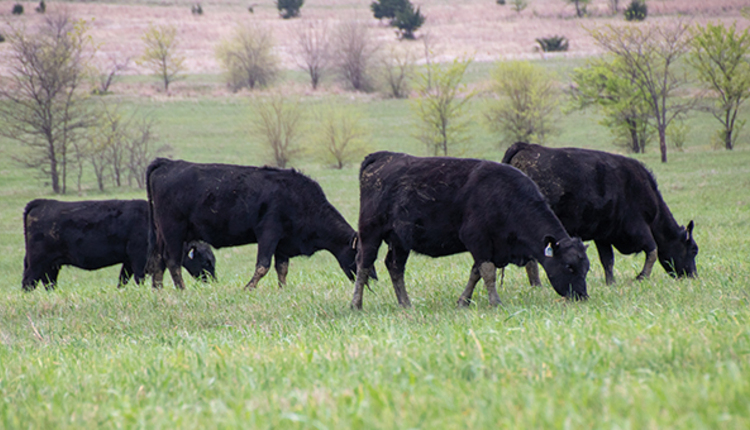How low can you go? |
| By Jim Gerrish |
|
|
The author is a rancher, author, speaker, and consultant with over 40 years of experience in grazing management research, outreach, and practice. He has lived and grazed livestock in hot, humid Missouri and cold, dry Idaho.  Gauge optimum grazing height on expected moisture availability. When it comes to feeding cows in the wintertime, grazed forage in the field is usually the lowest cost feed source. Grazing crop residues, annual forages, and stockpiled perennial pasture or range are all good opportunities to lower the cost of overwintering your cows compared to feeding hay or silage. When grazing crop residues, we need to balance feeding the cows with how much residue should be left behind for soil health and protection. There is obviously a lot more crop residue biomass associated with a 200-bushel per acre corn crop than with a 100-bushel crop. The general principle is that grain and stover yields are approximately equal. Thus, the 200-bushel crop has twice the biomass residue of a 100-bushel crop. If our land management objective is to leave a set amount of residue behind after grazing the stalks, then we can take many more grazing days off each acre with the higher crop yield. Stover fields differ Traditional thinking suggests harvesting 30 cow-days per acre (CDA) with set stocking on cornstalk fields. I usually write in terms of animal-unit days (AUD), but since most cattle producers think in terms of how many cows can they graze on stalks, I will use CDA in this article. A cow-day is generally between 30 to 35 pounds of dry matter. Thus, 30 CDA should be about equal to 1,000 pounds per acre of dry matter removed. A 100-bushel crop would be expected to produce 5,600 pounds of stover per acre while a 200-bushel corn crop would produce over 11,000 pounds per acre of stover. Does it make sense to plan for just 30 CDA of grazing from the 200-bushel crop field? If leaving behind 2 tons per acre of stover is good enough on a 100-bushel field, then we should be able to harvest three or four times as many CDA from a crop yielding 200 bushels per acre. Some cattle producers using controlled strip-grazing on cornstalks are routinely harvesting over 100 CDA. When it comes to reducing wintering costs, that level of yield is a game changer. The bottom line on grazing crop residues is that most producers could probably “go lower” than what they are currently doing. Take it all? What about grazing annual forages in the winter? How low should we take those? If it is a stockpiled summer annual forage, there is no expectation of any kind of regrowth, so the entire crop is available for grazing. Or is it? Shouldn’t we want to leave some residual behind for soil protection? As with the corn residue, I think there is a minimum amount of aboveground plant residue that should be left behind after grazing for the benefit of the soil. In a wet environment, I tend to use 2,000 pounds per acre as the target residue and 1,000 pounds per acre in a drier environment. In the dry environment, the total yield might only be 1,500 pounds per acre. That means our objective would be to graze off only about 500 pounds per acre or 16 to 17 CDA. In a wet environment, that same annual forage cover crop might yield 5,000 pounds per acre, allowing us to remove 3,000 pounds per acre or about 100 CDA. What I observe on my travels all around the country is most producers grazing in dry environments are removing too much biomass. Meanwhile, most producers in wet environments are not harvesting near the CDA that they could be getting if they were using controlled grazing. The bottom line on summer annuals grazed in winter is dryland producers are going too low while wet country or irrigated producers are not going low enough. Perennials are more complex Winter grazing management for perennial grasses gets complicated as we expect the plants to survive the winter and resume growth in the spring. I always emphasize the need to leave green leaf residual following every grazing event in the growing season. That is because leaves are the photosynthetic factory providing the energy to drive new plant growth. Without active leaves, plant recovery following grazing is much slower for most species. Do leaves that turn brown in autumn become green leaves again in the spring? No, they do not. So, why can’t we graze off all the leaves over winter? Speaking strictly from the standpoint of plant physiology, it is perfectly safe to remove all of those leaves. Where the problem lies is we need some insulation for the plant crowns and the soil itself to prevent freezing damage and potential winterkill. The farther north you live, the more important it is to leave more leaf cover behind after winter grazing. New leaves that develop in the spring generally come from leaf buds being fed by stored carbohydrates. For most bunchgrasses, that stored energy is in the stem bases, not below ground as many ranchers believe. Grazing perennial grasses too severely in the winter hinders their survival capacity and removes the energy source for new spring growth. Far too many cattle producers routinely graze too severely in the dormant season, reducing spring growth rate and production potential for the season. For perennial pastures, there is a limit as to how low you can go. This article appeared in the January 2021 issue of Hay & Forage Grower on page 19. Not a subscriber? Click to get the print magazine |
